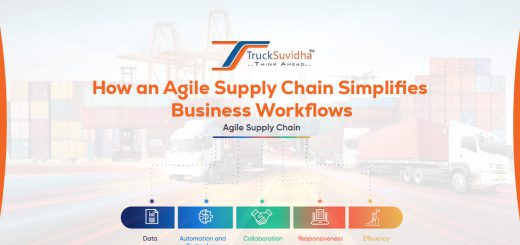Supply Chain Management: The Role of Technology in Modernization
Supply chain management is essential to company operations and key to success in the dynamic international business landscape. The evolution of supply chain management is becoming increasingly dependent on technological advancement because these innovations, efficiency, and sustainability are enhanced, encouraged, and embraced. The conventional supply chain management method frequently included manual procedures, little visibility, and reaction to interruptions. However, a new era of supply chain optimization has begun with the integration of cutting-edge technology.
Forecasting and Data Analysis
The extensive use of data analytics is a fundamental component of contemporary supply chain management. Use of big data by advanced analytics tools to deliver actionable insights into the different offerings. Predictive analytics can specifically help businesses optimize inventory, foresee shifts in demand, and spot possible outages. Businesses can increase predictive accuracy by utilizing machine learning algorithms and historical data, which will improve decision-making and resource allocation. By lowering the possibility of overstock or depletion and ultimately increasing supply chain efficiency, this data-driven strategy is exhausting.
The Real-Time Visibility and Internet of Things (IoT)
Connecting physical objects that have been around for a while to the internet has, quite literally, revolutionized supply chain management. Real-time tracking across the supply chain is possible by RFID tags that collect data from IoT devices and sensors that filter their signals. This enhanced visibility helps make quick decisions in changing circumstances and enhances inventory management.
Blockchain Technology: A means of Traceability and Transparency
Because it can create an unchangeable, transparent ledger of transactions, blockchain technology has become essential to supply chain management. This specialized, safe system makes it possible to trace products efficiently through the entire supply chain by maintaining consistent supply records. For example, the use of blockchain technology is critical in industries where traceability analysis is regularly done, like food and pharmaceuticals. Because it eliminates the need for multiple copies of documents, it lowers the possibility of fraud, forgery, or even error, which in turn raises stakeholder trust.
Demand Forecasting and Decision-Making with Artificial Intelligence (AI)
Systems dubbed “intelligent” have replaced nearly every aspect of supply chain management. Particularly, enormous advancements in decision-making and demand prediction are necessary for AI to progress enormously. Large data sets can be analyzed by AI algorithms to find trends, abnormalities, and predictive needs that are not possible with conventional techniques.
AI-based decision-making systems can also actively adjust inventory levels, routes, and production schedules to meet changing conditions, which can optimize supply chain management. This adaptability enhances overall adaptability and capacity to satisfy consumer demand.
Also Read:- How To Transform Your Supply Chain with Outsourced Logistics
Online Store Integration and Functionality
Flexibility in supply chain improvements is important due to the increasing popularity of e-commerce, and technology is crucial in fulfilling the demands of online retail. An essential component of the contemporary supply chain is automation centers, order management systems, and integrated e-commerce systems. Orders can be precisely processed and delivered on time thanks to the technology’s smooth communication between online platforms and delivery routes. Meeting customer expectations in an era where prompt and dependable delivery is a competitive advantage requires this integration.
Cooperatives and Supply Chain Networks
The cloud-based supply chain’s communication dimension enables the different stakeholders to connect. This facilitates instantaneous information sharing and collaboration between suppliers, retailers, transport operators, and manufacturers on forecasts and inventories.
Interconnected supply chains also increase the chain’s level of accountability and oversight. As a result, members of the chain can react swiftly to variations in supply or demand. This collaborative model maximizes the amount of stock on hand while lowering lead times throughout the supply chain.
Cybersecurity Guidelines to Safeguard Data
Sensitive information security in the supply chain becomes increasingly important as our reliance on technology grows. Data breaches and unwanted access are not accessible by cybersecurity measures like strong authentication protocols, and secure networks.
Strong security measures are essential to preserving trust and integrity in the supply chain ecosystem as it becomes more interconnected. These measures include safeguarding intellectual property rights, sensitive customer data, and privacy.
Challenges and Concerns
Even though technology has many advantages, there are implementation obstacles to acknowledge and overcome. Initial investments, the need for qualified staff to manage cutting-edge technology, and possible setbacks from cybersecurity threats or system failures are a few examples of these challenges.
Additionally, because technology is developing so quickly, businesses must be adaptive and flexible to successfully adopt new technologies. To fully realize the potential of contemporary supply chain management, employees must receive ongoing training and skill upgrades.
Conclusion
In conclusion, technology plays a transformative role in supply chain modernization. Every technological development, from data analytics to the Internet of Things breaks the chain. Artificial intelligence makes supply chains more effective, quicker, and sustainable. Companies that use these technologies strategically can boost customer satisfaction, get a competitive advantage, and face the challenges of the contemporary global marketplace with confidence. In the future, supply chain management will be undoubtedly shaped by continuous technological innovation, creating new opportunities and encouraging sustainable growth.




Recent Comments